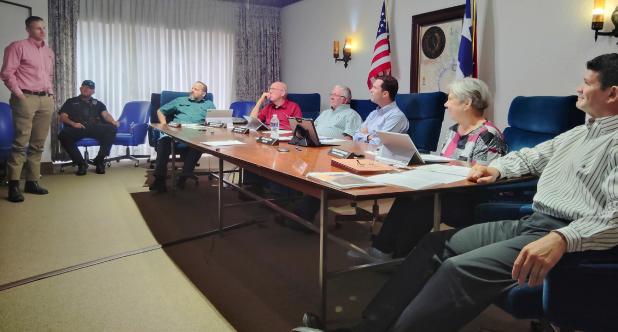
Council Puts Water Plant on Track
The Olney City Council approved a plan to build a new membrane-based water treatment plant, marking a turning point in a long and sometimes frustrating process to replace the city’s century-old water infrastructure.
The vote came at the Council’s April 14 meeting, following a detailed presentation from Jacob | Martin of Abilene, whose representatives laid out a strategy to replace Olney’s 106-year-old water treatment facility with a modern, efficient membrane filtration plant with a larger capacity than the current plant.
The Jacob | Martin engineers proposed repairing and using parts of Olney’s existing system with a custom-designed membrane plant. The new plant is projected to cost between $7.6 million and $10.6 million, depending on final design choices, and will be financed with funds raised from a $13-million revenue bond issued by the City in 2022. Interest earned has since brought the bond total to more than $14 million.
“This has been an ongoing project since about 2019 and we’ve looked at every different avenue,” Mayor Rue Rogers said shortly before polling the Council. “But I do feel … really good about the proposal … it’s within our budget and [has] the newer technology membrane system.”
Mayor Rogers said he had spoken with other towns that hired Jacob | Martin to design and build new water treatment facilities and had received “glowing” recommendations for both the firm and the new technology.
“They said, without a doubt, the membrane plant is the way to go,” he said.
Olney originally intended to build a conventional treatment plant, but the bids solicited by the City’s longtime engineers Corlett Probst & Boyd came in more than $1 million over budget. The Council tasked City Administrator Simon Dwyer with finding an engineering firm to update the existing plant, built in 1919, for $14 million or less. Mr. Dwyer’s search led him to Jacob | Martin, which created plans to refurbish the old plant as well as the proposal for the membrane plant.
The membrane filtration design offers better water quality, lower operational costs, and a more compact footprint - and can be built at the same cost as repairing the old plant, the engineers told the Council. The lifespan of the membrane plant is approximately 40 years - twice as long as the functionality expected from upgrading the existing plant, which has not had a major rehab since 2002, Tristan King, associate principal at Jacob | Martin told the Council.
Mr. King and his colleagues, senior principal Kirt Harle and electrical engineer Cole Carpenter, presented findings from their evaluation of the existing plant, including an assessment of aging equipment, deteriorating structures, and outdated safety features.
Despite the problems, the Olney plant “right now is producing very good [water] for how old it is,” Mr. King said, adding that the water quality would improve and maintain consistency throughout the year with a membrane plant.
“The membrane technology will also remove the possibility of any bad tastes that sometimes occur when the lake ‘turns over,’” Mr. Dwyer said.
Unlike conventional sandbased filtration, membrane systems use microscopic pores to remove harmful particles, providing what Mr. Harle described as an “absolute barrier” to contaminants. The system also offers automated controls, higher output capacity than the current plant, and modular components that are easier and less expensive to maintain.
The proposed design will allow the new plant to be built next to the existing one, eliminating service disruptions during construction. Once operational, the old plant will be decommissioned and demolished — costs already factored into the project estimates.
Now that the Council has approved the proposal, Jacob | Martin will begin the pilot phase, submitting a protocol to the Texas Commission on Environmental Quality (TCEQ) because membrane technology is considered an “alternative technology,” Mr. King said. That process, including manufacturer testing and state approvals, is expected to take six to eight months. Once a membrane vendor is selected, full design and construction will begin.
Completion of the new plant is expected within 18 to 24 months.
Any funds remaining after the plant is completed could be applied to other water infrastructure- related projects, including refurbishing the water towers and replacing aging water pipes, Mayor Rogers said.
